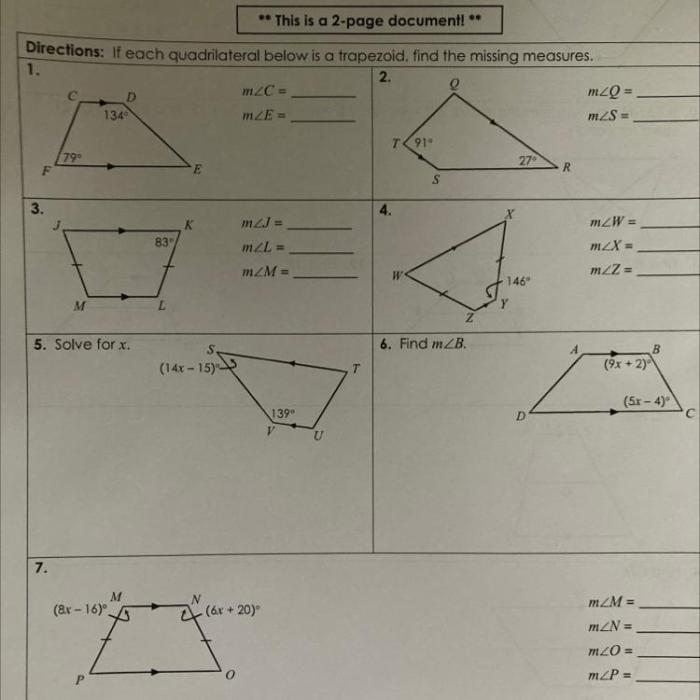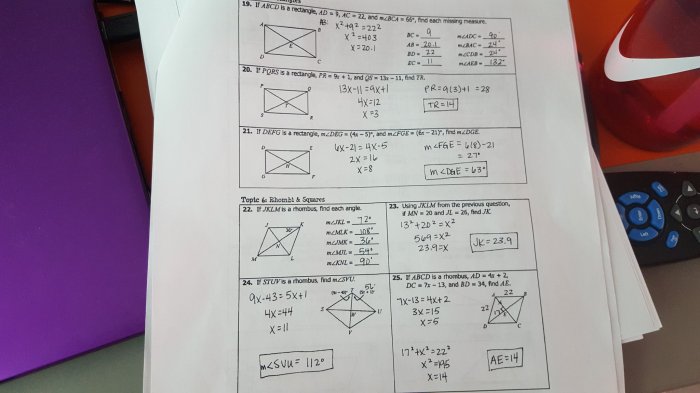Unit 7 Polygons and Quadrilaterals Homework 1 delves into the fascinating world of geometric shapes, introducing students to the fundamental concepts of polygons and quadrilaterals. This comprehensive homework assignment provides a thorough exploration of the properties, types, and transformations of these geometric figures, laying a solid foundation for further mathematical studies.
Throughout this homework, students will embark on a journey of discovery, delving into the unique characteristics of different polygons and quadrilaterals. They will learn to identify, classify, and analyze these shapes, gaining a deeper understanding of their geometric properties. Furthermore, the assignment explores the concepts of perimeter, area, symmetry, and congruence, providing students with essential tools for solving geometric problems and developing their spatial reasoning skills.
Quadrilaterals and Their Properties
Quadrilaterals are polygons with four sides and four vertices. They come in various shapes and sizes, each with unique properties that distinguish them from other quadrilaterals.
Types of Quadrilaterals
- Square: A quadrilateral with four equal sides and four right angles.
- Rectangle: A quadrilateral with four right angles and opposite sides equal in length.
- Parallelogram: A quadrilateral with opposite sides parallel and equal in length.
- Trapezoid: A quadrilateral with one pair of parallel sides.
- Kite: A quadrilateral with two pairs of adjacent sides equal in length.
Polygons and Their Properties: Unit 7 Polygons And Quadrilaterals Homework 1

Polygons are closed figures with three or more straight sides and angles. They are classified based on the number of sides and vertices they possess.
Types of Polygons
- Triangle: A polygon with three sides and three vertices.
- Quadrilateral: A polygon with four sides and four vertices.
- Pentagon: A polygon with five sides and five vertices.
- Hexagon: A polygon with six sides and six vertices.
- Octagon: A polygon with eight sides and eight vertices.
Perimeter and Area of Polygons

The perimeter of a polygon is the sum of the lengths of all its sides. The area of a polygon is the measure of the region enclosed by its sides.
Calculating Perimeter and Area
Perimeter: For a regular polygon, the perimeter can be calculated as P = n × s, where n is the number of sides and s is the length of each side.
Area: The area of a regular polygon can be calculated using the formula A = (1/2) × P × a, where P is the perimeter and a is the apothem (the distance from the center to a side).
Symmetry and Congruence of Polygons

Symmetry refers to the balance and repetition of a figure around a central point or axis. Congruence, on the other hand, describes figures that have the same shape and size.
Types of Symmetry
- Line Symmetry: A figure is line-symmetric if it can be folded in half along a line and the two halves match exactly.
- Rotational Symmetry: A figure has rotational symmetry if it can be rotated around a point and looks the same after a certain number of degrees.
Determining Congruence, Unit 7 polygons and quadrilaterals homework 1
Two polygons are congruent if they have the same shape and size. To determine congruence, you can use the following criteria:
- Side-Side-Side (SSS): If the corresponding sides of two polygons are equal in length, the polygons are congruent.
- Side-Angle-Side (SAS): If two sides and the included angle of one polygon are equal to the corresponding sides and angle of another polygon, the polygons are congruent.
- Angle-Side-Angle (ASA): If two angles and the included side of one polygon are equal to the corresponding angles and side of another polygon, the polygons are congruent.
Transformations of Polygons
Transformations are operations that move or change the shape of a figure without changing its size or shape. The three main types of transformations are translation, rotation, and reflection.
Types of Transformations
- Translation: Moving a figure from one point to another without changing its orientation.
- Rotation: Turning a figure around a fixed point.
- Reflection: Flipping a figure over a line of reflection.
FAQs
What is the definition of a polygon?
A polygon is a closed two-dimensional figure with straight sides.
What are the different types of quadrilaterals?
The different types of quadrilaterals include squares, rectangles, parallelograms, trapezoids, and kites.
How do you calculate the perimeter of a polygon?
To calculate the perimeter of a polygon, you add up the lengths of all its sides.

